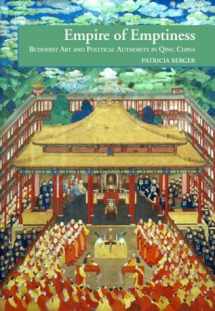
Empire of Emptiness: Buddhist Art and Political Authority in Qing China
ISBN-13:
9780824825638
ISBN-10:
0824825632
Author:
Patricia Ann Berger
Publication date:
2003
Publisher:
Univ of Hawaii Pr
Format:
Hardcover
266 pages
FREE US shipping
Book details
ISBN-13:
9780824825638
ISBN-10:
0824825632
Author:
Patricia Ann Berger
Publication date:
2003
Publisher:
Univ of Hawaii Pr
Format:
Hardcover
266 pages
Summary
Empire of Emptiness: Buddhist Art and Political Authority in Qing China (ISBN-13: 9780824825638 and ISBN-10: 0824825632), written by authors
Patricia Ann Berger, was published by Univ of Hawaii Pr in 2003.
With an overall rating of 4.5 stars, it's a notable title among other
books. You can easily purchase or rent Empire of Emptiness: Buddhist Art and Political Authority in Qing China (Hardcover) from BooksRun,
along with many other new and used
books
and textbooks.
And, if you're looking to sell your copy, our current buyback offer is $0.3.
Description
Imperial Manchu support and patronage of Buddhism, particularly in Mongolia and Tibet, has often been dismissed as cynical political manipulation. Empire of Emptiness questions this generalization by taking a fresh look at the huge outpouring of Buddhist painting, sculpture, and decorative arts Qing court artists produced for distribution throughout the empire. It examines some of the Buddhist underpinnings of the Qing view of rulership and shows just how central images were in the carefully reasoned rhetoric the court directed toward its Buddhist allies in inner Asia. The multilingual, culturally fluid Qing emperors put an extraordinary range of visual styles into practice--Chinese, Tibetan, Nepalese, and even the European Baroque brought to the court by Jesuit artists. Their pictorial, sculptural, and architectural projects escape easy analysis and raise questions about the difference between verbal and pictorial description, the ways in which overt and covert meaning could be embedded in images through juxtaposition and collage, and the collection and criticism of paintings and calligraphy that were intended as supports for practice and not initially as works of art. "All scholars of the Qianlong era, of early modern Mongol studies, of Tibetan Buddhism, and of pre-modern China studies will find the book indispensable." --- Pamela Crossley, Dartmouth College "More than any other art historical study to appear recently, this book expands our view of the visual culture of late imperial China by highlighting its ethnic complexity." --- Marsha Haufler, University of Kansas


We would LOVE it if you could help us and other readers by reviewing the book
Book review

Congratulations! We have received your book review.
{user}
{createdAt}
by {truncated_author}


